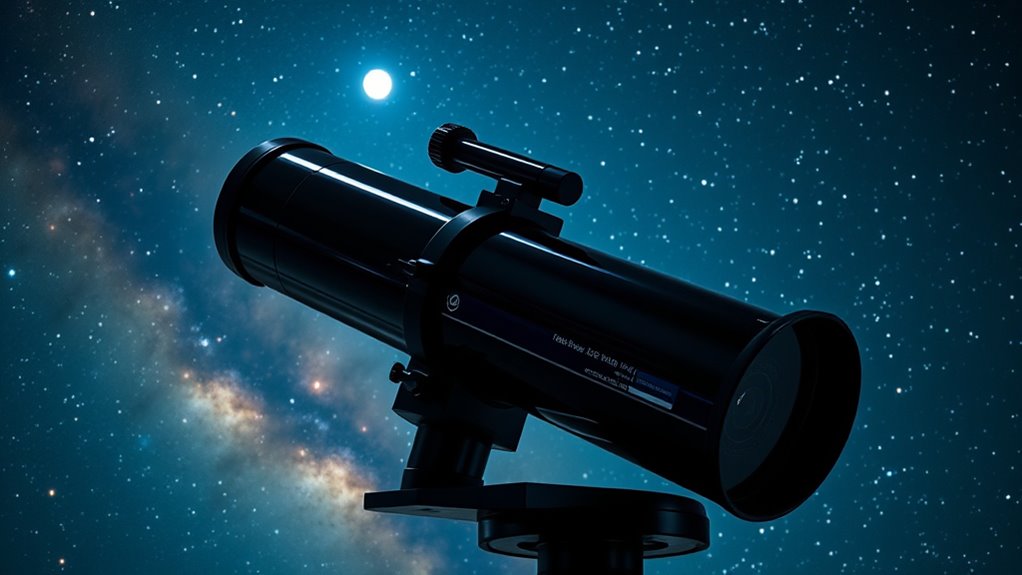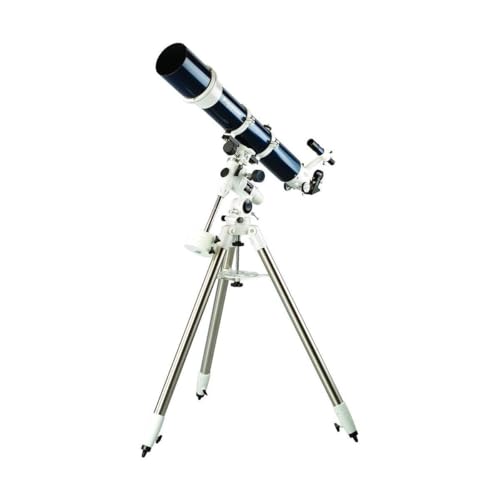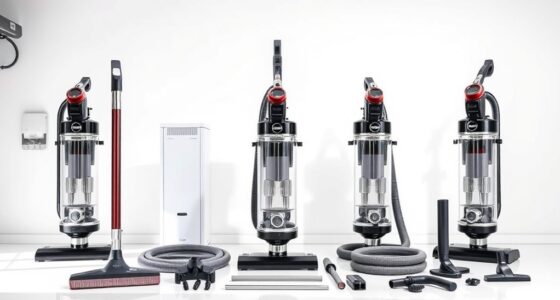If you’re looking to capture the cosmos like a pro, 130mm triplet APO refractors are a fantastic choice. These telescopes offer excellent optical quality, low chromatic aberration, and impressive portability. Models like the Explore Scientific ED102 and Askar 120APO provide high-contrast images perfect for astrophotography. I’ve found that focusing mechanisms and durable builds enhance the experience, making them user-friendly. Stick around to discover the best options available and what factors to contemplate for your perfect telescope.
Key Takeaways
- Look for triplet APO refractors with ED glass to ensure minimal chromatic aberration and sharp, color-accurate images for astrophotography.
- Opt for models with a focal length around 130mm and a focal ratio of f/6 to f/7 to enhance light-gathering capabilities.
- Select refractors featuring dual-speed focusers for precise focusing adjustments, crucial for capturing detailed celestial images.
- Consider build quality, including weather resistance and portability, to facilitate outdoor use and transportability during astrophotography sessions.
- Evaluate price versus optical performance, ensuring the chosen model offers high-value optics and features for your astrophotography needs.
SVBONY SV105 Telescope Camera for Astrophotography
If you’re a beginner in astrophotography, the SVBONY SV105 Telescope Camera is an excellent choice that makes capturing stunning images of the moon and planets a breeze. With its 1/2.8-inch IMX307 CMOS sensor, I can shoot high-quality images at 1920×1080 resolution and record 2K videos effortlessly. Its plug-and-play feature means no complicated setups, just connect it to my telescope and start shooting. The dark light compensation technology ensures I get clear images even in low-light conditions. Plus, it easily connects to my laptop, allowing for real-time observation. This camera truly simplifies the astrophotography experience for beginners like me.
Best For: Beginners in astrophotography looking for an easy-to-use camera for capturing lunar and planetary images.
Pros:
- Plug-and-play setup allows for quick and easy installation without the need for driver installation.
- High-quality imaging with a 1/2.8-inch IMX307 CMOS sensor, capturing images at 1920×1080 resolution and supporting 2K video recording.
- Dark light compensation technology enhances image clarity in low-light conditions, making it suitable for night sky photography.
Cons:
- Limited compatibility with certain devices, not supporting iOS devices like phones or tablets.
- Requires specific software for different operating systems (e.g., Sharpcap for Windows), which may be a hurdle for some users.
- Entry-level performance may not satisfy advanced astrophotographers looking for high-end features and quality.
Celestron Omni XLT 120 Refractor Telescope
The Celestron Omni XLT 120 Refractor Telescope stands out for amateur astronomers who crave high-quality optics coupled with precise tracking capabilities. With hand-selected optical glass and StarBright XLT coatings, it maximizes light transmission, ensuring stunning clarity. The ultra-precise CG-4 manual German equatorial mount offers smooth tracking and stability, making observations a breeze. I appreciate the included accessories, like the 6×30 finderscope and sturdy steel tripod, which get me started right away. Plus, the bonus Starry Night software opens up access to over 36,000 celestial objects, enhancing my stargazing experience. It’s truly a fantastic setup for any aspiring astrophotographer.
Best For: Amateur astronomers seeking high-quality optics and precise tracking for stargazing and astrophotography.
Pros:
- Exceptional optical quality with hand-selected glass and multi-coated lenses for maximum light transmission and clarity.
- Smooth tracking and stability provided by the ultra-precise CG-4 manual German equatorial mount.
- Comprehensive accessories included, such as a finderscope, sturdy tripod, and bonus astronomy software for enhanced learning and exploration.
Cons:
- Manual mount operation may be challenging for beginners unfamiliar with equatorial tracking.
- Limited portability due to the size and weight of the telescope and tripod.
- Requires additional eyepieces for varying magnifications, as only one eyepiece is included in the set.
SVBONY SV550 Triplet APO Telescope for Astrophotography
For those passionate about deep space astrophotography, the SVBONY SV550 Triplet APO Telescope stands out with its impressive 122mm aperture and FPL-51 triplet apochromatic lens. Weighing just 6.44kg, it’s compact and easy to transport, perfect for outdoor adventures. The dual-speed 2.5-inch focuser allows for precise adjustments, ensuring sharp images of distant galaxies and nebulae. With superior optical design, this telescope minimizes chromatic aberration, delivering stunning clarity. The 300mm dovetail rail provides stable mounting, enhancing overall balance during use. Whether you’re imaging or observing, the SV550 offers versatility and quality for any amateur astronomer looking to capture the cosmos.
Best For: Amateur astronomers and astrophotographers seeking a portable telescope with high-quality optics for deep space observation and imaging.
Pros:
- Superior optical design with FPL-51 triplet lens minimizes chromatic aberration for clear, detailed images.
- Lightweight and compact at 6.44kg, making it easy to transport for outdoor use.
- Dual-speed focuser allows for precise focusing, crucial for capturing sharp images of celestial objects.
Cons:
- The 122mm aperture may not gather as much light as larger telescopes, potentially limiting views of very faint objects.
- Requires additional accessories for full astrophotography setup, which may increase the overall cost.
- The compact design may limit some users in terms of advanced features found in larger telescopes.
Explore Scientific ED80 Essential Series Apochromatic 80mm Telescope
Designed with portability in mind, the Explore Scientific ED80 Essential Series Apochromatic 80mm Telescope stands out as an excellent choice for amateur astronomers and astrophotographers alike. Its FCD1 HOYA ED glass and multi-layer coatings deliver high-contrast, sharp images with minimal chromatic aberration. Weighing just 5.95 pounds, it’s perfect for spontaneous stargazing. While the scope performs well for astrophotography, I recommend upgrading the mount for better stability. Users rave about its image quality, but minor adjustments may be needed for ideal use. Overall, it’s a compact, versatile option that doesn’t compromise on performance, making it a worthy investment.
Best For: Amateur astronomers and astrophotographers seeking a portable telescope with excellent optical quality.
Pros:
- High-contrast, sharp images due to FCD1 HOYA ED glass and multi-layer coatings.
- Lightweight and compact design at 5.95 pounds, ideal for spontaneous stargazing.
- Suitable for both visual observation and astrophotography with minimal chromatic aberration.
Cons:
- Mounting may require upgrades for better stability and usability.
- Some users report minor manufacturing defects, such as sharp focuser edges.
- Finder scope mount is proprietary, often needing additional rings or adapters.
Explore Scientific FCD100 Series 127mm f/7.5 Carbon Fiber Triplet ED APO Refractor Telescope
Looking for a lightweight yet durable telescope for astrophotography? The Explore Scientific FCD100 Series 127mm f/7.5 Carbon Fiber Triplet ED APO Refractor Telescope might catch your eye. Weighing just 14 pounds, it combines a 127mm aperture and high-quality carbon fiber construction to minimize chromatic aberration. With a resolution of 0.9 arcseconds, you’ll capture stunning planetary and lunar details. However, customer reviews are mixed, noting issues with the focuser and customer service. Before buying, consider eyepiece compatibility and potential upgrades. Overall, while it offers decent optics, weigh its value against other options in the market.
Best For: Amateur astronomers and astrophotographers seeking a lightweight, durable telescope with good optical performance for planetary and lunar observation.
Pros:
- Lightweight construction: At 14 pounds, it’s easy to transport and set up for on-the-go astrophotography.
- High-quality optics: The 127mm aperture and f/7.5 focal ratio provide sharp images with minimal chromatic aberration.
- Good resolution: With a resolution of 0.9 arcseconds, it captures detailed views of celestial objects.
Cons:
- Mixed customer reviews: Users report dissatisfaction with optical performance relative to the price, raising concerns about value.
- Focuser and diagonal quality issues: Some customers find these components inadequate for the telescope’s price point.
- Customer support challenges: Reports of poor warranty support and difficulty in obtaining manuals could complicate ownership.
Explore Scientific ED102 Essential Series Apochromatic 102mm Triplet Refractor Telescope
The Explore Scientific ED102 Essential Series Apochromatic 102mm Triplet Refractor Telescope stands out as an exceptional choice for astrophotographers who demand high optical quality and performance. Its FCD1 HOYA extra-low dispersion glass and multi-layer coatings deliver high-contrast images with remarkable detail. The air-spaced triplet design virtually eliminates chromatic aberrations, making it perfect for capturing the Moon, planets, and deep-sky objects. Weighing in at only 714mm focal length, it’s portable and easy to set up. Plus, the built-in handle and push-pull collimation adjustments guarantee you get the best possible star images every time.
Best For: The Explore Scientific ED102 Essential Series Apochromatic 102mm Triplet Refractor Telescope is best for astrophotographers seeking high-quality optics and portability for capturing detailed images of celestial objects.
Pros:
- High-contrast images with stunning detail due to FCD1 HOYA extra-low dispersion glass and multi-layer coatings.
- Air-spaced triplet design effectively eliminates chromatic aberrations, enhancing astrophotography capabilities.
- Lightweight and easy to set up with a retractable dew shield and built-in handle for portability.
Cons:
- May require additional accessories for optimal astrophotography performance.
- The 102mm aperture may not be sufficient for advanced astrophotographers seeking to capture fainter deep-sky objects.
- Limited to a specific focal length of 714mm, which may not suit all viewing preferences.
Celestron StarSense Explorer DX 130AZ App-Enabled Telescope
For anyone enthusiastic to plunge into astrophotography without prior experience, the Celestron StarSense Explorer DX 130AZ App-Enabled Telescope stands out with its innovative smartphone integration. This 130mm Newtonian reflector delivers sharp views of the Moon, Jupiter, and even deep-sky wonders like the Orion Nebula. With its patented StarSense technology, I can easily locate celestial objects using my phone—just dock it and follow the app’s guidance. The user-friendly manual mount lets me make precise adjustments, making stargazing accessible. Plus, Celestron’s solid reputation and two-year warranty offer peace of mind as I explore the cosmos.
Best For: Beginners looking to explore astronomy and astrophotography with an easy-to-use, app-enabled telescope.
Pros:
- User-Friendly: The StarSense technology and app guidance make it simple for beginners to locate celestial objects.
- Impressive Optical Performance: The 130mm aperture provides clear and detailed views of the Moon, planets, and deep-sky objects.
- Reliable Brand Support: Celestron offers a two-year warranty and unlimited customer support from US-based experts.
Cons:
- Limited Advanced Features: More experienced astronomers may find the telescope lacks advanced features for in-depth astrophotography.
- Manual Tracking: The manual altazimuth mount requires physical adjustments, which may be less convenient compared to motorized mounts.
- Smartphone Dependency: Users must have a compatible smartphone to utilize the StarSense technology effectively.
Askar 120APO Telescope for Astrophotography and Viewing
With its impressive 120mm aperture and F7 focal ratio, the Askar 120APO telescope stands out as an excellent choice for astrophotography enthusiasts and casual stargazers alike. The triplet air-spaced APO design, featuring an ED glass element, guarantees I capture sharp, color-accurate images. Weighing 5.7kg, it’s manageable for transport, and the included accessories—like tube rings and a dovetail plate—make setup a breeze. Whether I’m viewing distant galaxies or snapping stunning celestial photos, this telescope’s 840mm focal length shines. Plus, its versatility and user-friendly design truly enhance my stargazing experience. I can’t recommend it enough!
Best For: Astrophotography enthusiasts and casual stargazers seeking a high-quality telescope for capturing sharp, color-accurate celestial images.
Pros:
- Exceptional 120mm aperture and F7 focal ratio provide excellent light-gathering capability for detailed observation and imaging.
- Triplet air-spaced APO design with ED glass ensures sharp, color-accurate images, ideal for astrophotography.
- Lightweight and portable at 5.7kg, making it easy to transport and set up for various stargazing locations.
Cons:
- The price point may be higher compared to beginner-level telescopes, which could deter novice users.
- Slightly longer focal length (840mm) may require additional adjustments for certain astrophotography setups.
- Limited to visual adapters compatible with rear-end thread, which may restrict some accessory options.
Explore Scientific FCD100 Series 80mm Apochromatic Triplet Refractor Telescope
Offering exceptional optical quality, the Explore Scientific FCD100 Series 80mm Apochromatic Triplet Refractor Telescope is perfect for astrophotographers seeking to capture stunning celestial images. With its Hoya FCD100 extra-low dispersion glass and air-spaced triplet design, I love how it virtually eliminates chromatic aberrations, delivering sharp details of the Moon, planets, and more. The 80mm aperture and f/6 focal ratio make it easy to photograph deep-sky objects with minimal distortion. Weighing just 7 pounds, its compact design guarantees portability for spontaneous stargazing sessions. Plus, the included accessories enhance usability, making this telescope a fantastic choice for any astronomy enthusiast.
Best For: Amateur astronomers and astrophotographers seeking a high-quality, portable telescope for capturing detailed images of celestial objects.
Pros:
- High optical quality with Hoya FCD100 extra-low dispersion glass, minimizing chromatic aberrations for sharp, detailed views.
- Lightweight and compact design (7 pounds, 22 x 8 x 8 inches) that allows for easy transport and spontaneous stargazing.
- Versatile accessories including a dew shield, hybrid finder scope base, and a precise two-speed focuser enhance usability.
Cons:
- Limited aperture size (80mm) may not gather as much light as larger telescopes for very faint objects.
- Price point may be higher compared to entry-level telescopes, making it less accessible for beginners.
- Astrophotography requires additional equipment (like a camera and mount) which may not be included.
Explore Scientific ED102 Apochromatic Triplet Refractor Telescope
The Explore Scientific ED102 Apochromatic Triplet Refractor Telescope stands out for its exceptional imaging performance, making it an ideal choice for astrophotographers seeking high-quality results. With a 102mm aperture and f/7 focal ratio, this telescope delivers sharp, vibrant images thanks to its genuine HOYA FCD100 extra-low dispersion glass and proprietary EMD coatings. I love that it’s designed for advanced chromatic aberration correction, achieving an impressive resolution of 1.14 arcseconds. Weighing just 10.9 lbs, it’s portable enough for field trips. If you’re serious about capturing the cosmos, this telescope will elevate your astrophotography experience.
Best For: Astrophotographers and astronomy enthusiasts looking for a high-performance refractor telescope with exceptional imaging capabilities.
Pros:
- High-quality optics with genuine HOYA FCD100 ED glass for superior image clarity.
- Advanced chromatic aberration correction for vibrant and sharp visuals.
- Portable design at 10.9 lbs, making it suitable for field observations and travel.
Cons:
- OTA only, requiring additional investment in mounts and accessories.
- May be less suitable for beginners due to its advanced features and specifications.
- The focal length of 714mm may limit wide-field observations without additional focal reducers.
Factors to Consider When Choosing 130MM Triplet APO Refractors for Astrophotography

When choosing a 130mm triplet APO refractor for astrophotography, I think it’s vital to take into account several key factors. Optical quality, aperture, and focal length play significant roles in the images you’ll capture. Plus, you can’t overlook build quality and portability if you plan to take your setup on the go.
Optical Quality and Design
Optical quality and design are essential factors that profoundly impact your astrophotography experience with 130mm triplet APO refractors. The type of ED or FCD glass used in the lenses is important, as it minimizes chromatic aberration, resulting in sharper images. An air-spaced triplet design is another significant advantage, ensuring that optical elements maintain consistent alignment and preventing contact that could introduce aberrations. Additionally, fully multi-coated optics enhance light transmission and contrast, giving you brighter, clearer images. Keep in mind the focal ratio, often around f/7, as it influences light-gathering ability and field of view for various astrophotography needs. Finally, the overall construction quality, including optical alignment and collimation, is key for optimal performance and minimal distortions.
Aperture and Focal Length
Choosing the right aperture and focal length is essential for achieving stunning results in astrophotography with 130mm triplet APO refractors. The 130mm aperture plays a pivotal role in light-gathering, considerably enhancing the brightness and detail in your images. Typically, these refractors have focal lengths around 850mm to 950mm, which influence magnification and field of view. A longer focal length provides higher magnification but narrows your view. The focal ratio, calculated from these dimensions, affects exposure times and determines the telescope’s suitability for various astrophotography types. By balancing aperture and focal length, you can capture fine details in deep-sky objects while maintaining versatility for both wide fields and high-magnification planetary views.
Chromatic Aberration Control
While exploring 130mm triplet APO refractors for astrophotography, it’s essential to take into account how effectively they manage chromatic aberration. These triplet designs use three lenses, including low-dispersion elements, to minimize color fringing across the visible spectrum. I’ve found that the air-spaced configuration enhances optical correction, resulting in sharper and more color-accurate images of celestial objects. Pay attention to high-quality ED glass elements like FPL-51 or HOYA FCD100, as they greatly reduce residual chromatic aberration. Proper optical alignment and collimation are also crucial for maintaining minimal aberration. Overall, a well-engineered 130mm triplet APO refractor offers superior control of chromatic aberration compared to doublet designs, especially at higher magnifications.
Build Quality and Durability
When considering a 130mm triplet APO refractor for astrophotography, I can’t stress enough the importance of build quality and durability. High-quality refractors feature air-spaced, ED glass lenses that not only correct chromatic aberration but also deliver sharp, detailed images. I prefer models with weather-resistant coatings and sturdy optical tubes, ensuring they withstand outdoor conditions during long sessions.
Look for precision-machined mechanical components, like focusers and mount attachments made from brass or high-grade aluminum. Robust fittings, secure dovetails, and weather-sealed ports enhance durability and ease of use. Finally, features like retractable dew shields and shock-absorbing rings help prevent damage and maintain optical alignment, making these refractors a reliable choice for capturing the cosmos.
Portability and Weight
Portability and weight are essential factors to contemplate because they directly impact how easily I can transport and set up my 130mm triplet APO refractor for astrophotography. With weights ranging from about 5.95 to 14 pounds, I find that lighter models are generally easier to manage during travel. Compact designs and materials like carbon fiber enhance portability, making those shorter focal lengths more appealing. However, heavier models over 10 pounds often require robust mounts, which can be cumbersome. Features like retractable dew shields and carrying cases also make a difference, simplifying transportation. Ultimately, considering the size and weight helps me decide if the telescope fits my mobile astrophotography needs or if it’s better suited for a fixed observatory setup.
Focusing Mechanism Efficiency
Selecting a 130mm triplet APO refractor for astrophotography demands careful attention to the focusing mechanism’s efficiency, as it directly influences the clarity of my images. I find a dual-speed focuser with a 1:10 gear ratio invaluable for making precise adjustments, ensuring sharp focus. Co-axial knobs allow me to quickly switch between coarse focusing and fine-tuning without disturbing the telescope’s alignment, which is vital for image clarity. Additionally, push-pull collimation adjustments at the front cell help maintain optical alignment, enhancing focus accuracy. An efficient mechanism minimizes backlash, reducing repetitive adjustments during long imaging sessions. Ultimately, a stable focuser with low friction ensures I can securely lock focus, maintaining image stability throughout my exposures.
Compatibility With Accessories
Choosing a 130mm triplet APO refractor for astrophotography isn’t just about the optics; compatibility with accessories is essential for a seamless experience. First, I make sure the telescope’s focuser supports standard sizes like 2.5-inch or 3-inch, so I can use a variety of auto-guiders and accessories. Next, I check that the diagonal and eyepieces match the telescope’s barrel diameter, typically 1.25-inch or 2-inch, for smooth integration. It’s also *vital* to confirm that the mounting system works with common dovetail plates like Vixen or Losmandy, allowing for flexible setups. *Finally*, I verify the back focus distance is adequate for attaching cameras and other imaging gear without vignetting, ensuring I can fully explore astrophotography techniques.
Price and Value Comparison
When it comes to evaluating price and value in 130mm triplet APO refractors for astrophotography, there are several key factors I consider. Higher-priced models often boast premium optics and build quality, but I’ve found that cheaper options can still deliver impressive performance. I look closely at the scope’s optical design, coatings, and included accessories, as these elements substantially influence imaging quality relative to cost. Budget-friendly models may have issues like mount compatibility or inferior focusers, which can undermine their value. Additionally, brand reputation, customer support, and warranty terms also play a vital role in my decision-making process. Ultimately, I compare actual optical performance, such as chromatic aberration correction, against the price to guarantee I’m making a smart investment.
Frequently Asked Questions
What Is the Best Mount for 130MM Triplet APO Refractors?
I’ve found that a sturdy equatorial mount, like the Sky-Watcher EQ6-R Pro, works best for my 130mm triplet APO refractor. Its load capacity guarantees stability during long exposures, and the tracking accuracy is impressive. I love how easy it is to set up and align, making my astrophotography sessions smoother. Plus, it’s compatible with various accessories, which gives me flexibility as I explore the night sky.
How Do I Maintain My Triplet APO Refractor Telescope?
I maintain my triplet APO refractor telescope by regularly checking the optics for dust and cleaning them with a soft brush or microfiber cloth. I guarantee the mount is stable and free of debris. I also check the alignment and collimation, making adjustments as needed. Storing it in a protective case when not in use helps prevent damage. Finally, I keep the lenses capped to avoid scratches and moisture buildup.
Can I Use a 130MM Triplet APO for Visual Observation?
Oh sure, you can absolutely use a 130mm triplet APO for visual observation—if you enjoy seeing the stars in stunning detail and clarity! I mean, who wouldn’t want to witness Saturn’s rings like they’re just a stone’s throw away? I’ve done it myself, and let me tell you, the views are breathtaking. So grab that telescope, find a dark spot, and prepare to be amazed. You’ll never look at the night sky the same way again!
What Accessories Enhance Astrophotography With Triplet APO Refractors?
To enhance astrophotography with triplet APO refractors, I recommend a sturdy mount for stability, a good-quality field flattener to correct distortions, and a reliable guide scope for precise tracking. I’ve found that using a dedicated camera, like a DSLR or a cooled CCD, greatly improves image quality too. Don’t forget a remote shutter release to minimize vibrations and a filter wheel for versatility in capturing different wavelengths!
How Does Light Pollution Affect Astrophotography With These Telescopes?
Light pollution can be a sneaky little gremlin when it comes to astrophotography. It dims the beauty of celestial wonders, making it tough to capture those delicate details. I’ve found that even my best shots can suffer from washed-out colors and reduced contrast. To combat this, I often seek darker skies or use filters that help reclaim the lost brilliance. It’s all about finding ways to dance around those urban lights!
Conclusion
In my journey through the stars, I’ve found that choosing the right 130mm triplet APO refractor can transform your astrophotography experience. Coincidentally, each model we’ve explored offers unique strengths that cater to different needs, making it easier for you to capture the cosmos like a pro. So, whether you’re drawn to the precision of the Explore Scientific series or the versatility of the Askar 120APO, you’re bound to find a telescope that resonates with your celestial ambitions.




















